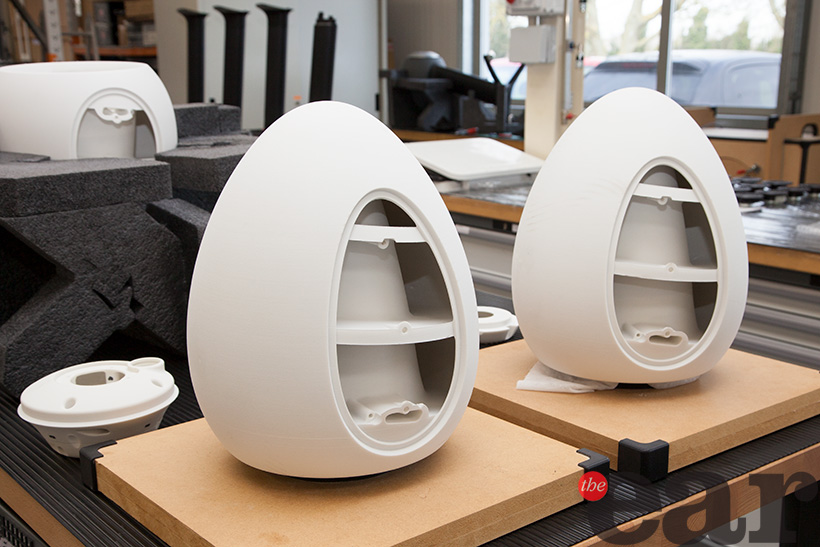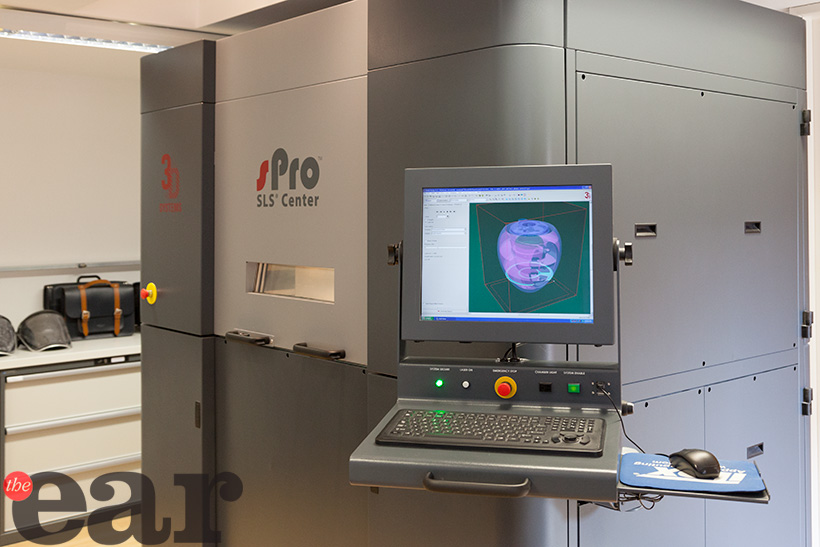Node is not your regular audio company, very little about it is reminiscent of traditional manufacturing techniques, in fact almost the only thing that is is that it was started by two blokes. But these weren’t die-hard audiophiles blowing the pension on a hobby that had got out of hand, they were partners in a successful industrial design company, one of whom has a penchant for sound quality despite a background in automotive design. Ashley May (the hi-fi nut) and product designer David Evans (who used to merely enjoy music) run Studio 17 at a facility near Cambridge called ARCC Innovations, this describes itself as “A collaborative working environment for entrepreneurial people, inventors, and technologists who have interesting products and business ideas they want to bring to life.” Which in practise means offering machinery and expertise to the companies that use it, for Node that is the means to produce the very high tech Hylixa, a loudspeaker that is genuinely like no other on the market.

Raw Hylixa cabinets with driver baffle at back left
What separates it from the rest is a helical transmission line that spirals around the inside of the egg like cabinet and vents around the mid and tweeter. However, the word cabinet is not really appropriate for this complex structure, the pictures hopefully reveal the way that the output of the bass driver, which faces the opposite direction to the mid and tweeter, is sent to the back of the chamber and then turns and spirals around it to vent at the front.

The mighty sintering machine
The Hylixa shape is produced in a laser sintering machine which fuses glass nylon powder granules together to create a solid form, it’s not unlike a 3D printer but results in a much harder and stronger structure. After 45 hours (per cabinet) what comes out of the machine is a block of powder that hides the form within it, getting it out is rather like archaeological discovery and takes a lot of time and patience. Ashley and David not only have to remove the powder from the outside but also from within the helix that winds around inside it, they use a remote camera to ensure that no powder is left in the line.

David Evans (left) and Ashley May
The raw Hylixa cabinet feels almost like ceramic but weighs less and is very inert and rigid, stress analysis has been done to keep the resonant frequency outside of the audio range so that there is no danger of it being excited and muddying the sound. The cabinet has 2mm taken off in one of ARCC’s CNC lathes to produce a smoother surface then it’s sent to a local finishing company for painting in virtually any colour. The baffle for the drive units is also laser sintered and provides a small volume behind the BMR midrange driver which allows output at the back of the polepiece to combine with that from the bass driver. The latter is bonded onto the back of the baffle using a jig to ensure concentricity.

Crossover cartridge slots into the base of the stand
The ‘head’ of this speaker is pretty clever and so is the stand, which is a lot more than just a stand because it also houses the crossover and is an integral part of the design that fixes seamlessly under the speaker. The crossover housing is almost as radical as the body of the speaker, each of the components that make it up sits in a slot within a ‘cartridge’ that slots into the base of the stand. These Mundorf components are hardwired together with silver plated cables for sound quality reasons and the inductors are placed at either end of the cartridge to minimise interaction, the design allowing for a far greater distance between them than normal crossovers. This is as close as you can get to putting the crossover in a separate enclosure without actually separating it from the speaker and while this has been proven to be beneficial by other speaker companies it remains uncommon because most users don’t want more boxes. I particularly like the way that the terminals are part of this design and arranged vertically to keep the exterior as slim as possible, that they are silver plated is another bonus. The cables that join the crossover to the drivers sit in a plastic tube within the aluminium leg so as to reduce any interaction between cable and aluminium, which apparently makes an audible difference.

Hylixa accessory kit with spikes and speaker cable plug unit
The facia that you see around the mid and tweeter is made from machined aluminium and can be had in 24kt gold, nickel and rose gold finishes, it can also be custom engraved should the buyer so wish. Custom finishing is very much part of the Node package, their website has a colour rendering facility so that you can get a good idea of what the speaker will look like in finishes other than those that have been photographed. Even the feet for the tripod stand are beautiful, the speaker is supplied with flat pads and elegant spikes in a finish to match the facia.

Node Audio dem room with Aurender and Soulution electronics
It’s worth noting that not only do the Node guys design, market and sell these speakers they also do the fabrication and assembly work. Which if nothing else proves that in the right environment and with the right people it is possible to build a technologically advanced and very high quality product with a small team, you have to hand it to them, Ashley and David have done a remarkable job.
Node Audio


